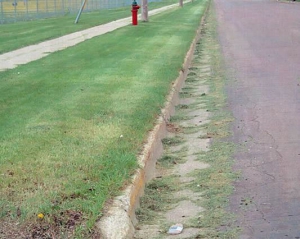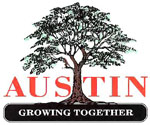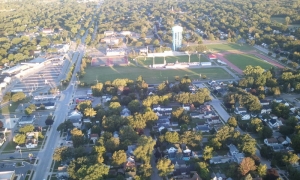Stormwater & Our Community
Stormwater Overview:
The City of Austin is situated in the Upper Cedar River watershed and is surrounded by Dobbins Creek, Murphy Creek, Turtle Creek, Wolf Creek and the Cedar River. On average, our City receives 34 inches of precipitation and 41 inches of snowfall each year. During a rain event or snowmelt, water falls onto impervious surfaces such as homes, buildings, roads and parking lots. Impervious surfaces do not allow water to be absorbed, and thus water is diverted into storm drains.
When water enters a storm drain it does not go to the wastewater treatment plant to be treated. It is directly sent into our rivers, lakes, and streams. As water travels across impervious surfaces, it picks up debris, chemicals and dirt. These types of pollutants can have major impacts on our waterbodies surrounding Austin. When these pollutants enter a waterbody they can be detrimental to aquatic life, recreation and human health. Your actions in and around our community have a great impact on the overall water quality of our surface water. Remember, we only want rain down our drains!
As the City of Austin continues to grow, it is vital to keep our waterbodies clean. To achieve this goal, remember to clean up after yourself to prevent pollutants from entering our waterbodies. By doing so, you will allow all community members to enjoy our local lakes and streams.
CHAPTER 20: STORMWATER MANAGEMENT ORDINANCE
The City of Austin adopted a Storm Water Utility Fee in 2003. Fee rates are based on the amount of run-off from the property. The more run-off, the greater the impact on surface waters. All property owners in the City are billed for stormwater. This includes all developed and undeveloped properties.
Storm water utility fees will be used on the following programs:
- Surface water management practices
- Detention basin construction and maintenance
- Storm sewer construction and maintenance
- Drainage systems maintenance and reconstruction
- Public education and outreach
- Ordinance implementation and enforcement
- Improvements to localized drainage problems
Storm Water Utility Fees as of November 1, 2022
| Developed Property | Monthly Cost |
| Single-Family Residential | $ 5.50 per lot |
| Twin Homes/Duplex | $ 5.50 per unit |
| Manufactured Home | $ 2.75 per unit |
| Apartment | $ 1.375 per unit |
| Recreational | $ 1.375 per acre |
| Institutional (churches/schools) | $ 24.75 per acre |
| Commercial | $ 33.00 per acre |
| Undeveloped Property | Monthly Cost |
| Residential | $ 220.00 per lot |
| Twin Homes/Duplex | $ 220.00 per unit |
| Manufactured Homes | $ 110.00 per unit |
| Apartment Building | $ 55.00 per unit |
| Recreational | $ 55.00 per acre |
| Institutional (churches/schools) | $ 412.50 per acre |
| Commercial | $ 550.00 per acre |
The storm water utility fee will be billed on your monthly utility bill and is identified as a specific line item. The monthly fee will not apply to agricultural land without a residence, parks, gravel pits, railroads or City owned property. Credits will be provided to private property owners who own and maintain detention/retention ponds.
Additional information is available at the Engineering Department at 507-437-9950
During the construction process, soil is highly vulnerable to erosion by wind and water. Eroded soil endangers water resources by reducing water quality and aquatic habitat for fish and other desirable species. Eroded soil also necessitates repair of sewers and ditches and the dredging of our lakes. The purpose of City Code § 20.05 is to safeguard persons, protect property, and prevent damage to the environment in the City.
Construction activities which disturb less than one acre of land, that are not part of a larger plan of development or sale, are considered “small construction sites” and are required to have a City Permit.
City of Austin – Small Construction Sites Permit Application
City of Austin – Common Plan of Development or Sale
Construction activities which disturb more than one acre of land, or are part of a larger common plan of development or sale, require a NPDES Construction Stormwater Permit (MNR10001), Stormwater Pollution Prevention Plan (SWPPP) and Plan approved by the City. A Subdivision Registration Form is also required for projects that are part of a common plan of development or sale.
MPCA Construction Stormwater General Permit (MNR100001)
MPCA Stormwater Pollution Prevention Plan Guidance
MPCA Subdivision Registration Form
Other permits may be required for your project. Contact the Engineering Department at 507-437-9950
The City of Austin prohibits all non-stormwater discharges into the storm water system. These
prohibited discharges can be through illicit connections or illegal dumping. A range of potentially
polluting activities would include construction projects, hazardous material handling, gas and service
station operations, used oil, and pesticide disposal.
The City of Austin has developed a Detection and Elimination Plan that includes the following:
- Respond to complaints or information relating to potential illicit discharges and illegal dumping
- Inspection program of the City storm sewer system
- Inspection of storm sewer outfalls
- Evaluation of available data on local receiving streams
To report suspected illicit discharges, contact the Engineering Department at 507-437-9950 or email: mrask@ci.austin.mn.us.

The City of Austin requests that property owners consider the impacts of grass clippings on the street and other paved areas. Grass clippings have the following impacts on our streams and lakes if they are allowed to enter the City storm sewer system. Keep Grass Clippings Off-Street and Other Paved Areas.
- Grass clippings contain phosphorus, the nutrient that turns lakes green with algae
- Grass clippings from actively growing lawns have 4 to 5 times more phosphorus
content than fallen autumn tree leaves - One bushel of fresh grass clippings can contain 0.1 lbs of phosphorus – enough to
produce 30 to 50 pounds of algae growth if it finds its way to a lake or river - When mowing, grass clippings should be directed away from the street, driveways,
sidewalks, or other paved areas. Curbside storm sewers can transport grass
clippings (along with other street debris and dirt) to near-by lakes, rivers and
wetlands - Grass clippings blown on the street, driveways, sidewalks or other paved areas
during mowing should be swept up and returned to the lawn or composted
If you have any questions, please contact the Engineering Department at 507-437-9950
The City of Austin provides a drop-off location for the annual fall yard waste program. The City has established the Cook Farm as the city-wide disposal site at 27th Avenue NW. This program is funded through the revenues generated by the lease at the Waste Transfer Station.
- The site will be open from late September through late November
- Open 7 days a week from dawn to dusk
- Drop-off is limited to the following yard waste:
- Leaves
- Grass
- Flowers and plants from gardens
- Compost from previous years yard waste is also available to the public on a first come first serve basis
If you have any questions, please contact the Engineering Department at 507-437-9950
Austin’s Public Works Department has an Adopt-A-Drain program launched in 2019 to get citizens to “adopt” specific storm drains in the community to keep cleared of litter and debris. Volunteers pick a storm drain on a city map and fill out an Adopt-A-Drain application; then they are expected to routinely sweep their storm drain to keep it clear of leaves and other debris.
Adopt-A-Drain volunteers should keep track of the total debris collection from the drain and inform the City. Those interested in adopting a City storm drain can view options on our website at:
If you have any questions, please contact the Engineering Department at 507-437-9950
The City of Austin conducts an annual Stormwater Pollution Prevention Plan (SWPPP) meeting that is open to the public each spring.
If you have any questions, please contact the Engineering Department at 507-437-9950
Important Links
MPCA
EPA
Cedar River Watershed District
Turtle Creek Watershed District
MN DNR
Mower County SWCD
MN Legacy

